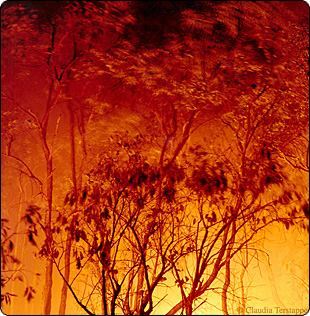14/12/2005
Claudia Terstappen
Metronom, Barcelona
Lugares de culto (Places of worship) deals with the problem of naming or representing, using the sacred as a way to stress the ambiguity of objectivity. Her photographs and videos can be seen as a critical revision of the German photographic tradition, her pictures don't try to create distance but closeness.

Lugares de culto
Lugares de culto (Places of worship) deals with the problem of naming or representing, using the sacred as a way to stress the ambiguity of objectivity or the assumed truth which a photographic image holds. Terstappen presents an installation of 8 huge photographs -4 of Australian forests and 4 of the Cruz del Romero chapels, in Andalusia- with five video art pieces that completes a general vision of the production of the artist and the way she works, where the idea of travel, with the experience of the world that it provides, takes a central place. This production of Metro'nom is made with the support of the Goethe Institute of Barcelona.
We feel that even if all possible scientific questions be answered, the problems of life have still not been touched at all. Ludwig Wittgenstein Tractatus Logico-Philosophicus
Lugares de culto (Places of worship) deals with religious expressions from different countries. Terstappen’s exhibition is a participation in worlds of belief. She documents and reflects about those sites men consider as sacred. Naming a place, an animal or an object as holy is giving it the potential to hold powers, obtaining answers perhaps to trascendent questions about love, fear, death and hope. Terstappen’s photographs and videos lead us into the spiritual world of powers and make us question and compare our own beliefs with what we experience in other parts of the world.
Terstappen’s pictures can be seen as a critical revision of the German photographic tradition. Unlike the objective taxonomies of August Sander or Bernard and Hilla Becher her pictures don’t try to create distance but closeness. Terstappen’s focus is on the spiritual world of different cultures, investigating in peoples beliefs and emotions.
In the Central room, her four images ‘Cruz del Romero’ show interiors of Spanish chapels. Their rich and colourful decoration is confronted with four photographs of Australian forests. These “natural altars" create a strong dialogue with the “made altars" from the south of Spain. We are not only faced wih our own beliefs and expectations in regard to religious imagery but understand that any imagery, object or site can become the representation of a higher entity depending on time, culture and location. A place is not sacred by itself: desire makes it become sacred.
The need to study and reflect other cultural beliefs lead Terstappen to also work with moving images. In Sequi room one of her video works continues her thoughts of photographic images and extends it geographically to Japan. We see rituals in shrines and temples in line with traditional physical exercise in public places and Pachinko (gambling) halls. Religion, modern technology and habits combine in the video to have the same power: they all represent places of worship. In Mat room she shows her video titled Fire, Water, Sky and Earth which documents the four elements, the foundation of all being.
At the rear of Central room we see the film 10 Seconds a Day which Terstappen made with zoologist Greg Wallis. The film invites the spectator to spend time in natural scenes which otherwise easily go unnoticed. It was filmed as a visual diary during a period of 8 months in the far north of Australia in 2003/2004. Short sections of images are lined up to form a record of significant elements of the natural world of the Aboriginal people. The land itself in all its shapes and forms holds stories of the creation period or the dreamtime and these stories form an integral part in the daily lives of the Aboriginal people. “Ginga", the Saltwater crocodile, is a powerful totem to Aboriginal people as it played an important role in the creation of the landscape. Many species of snakes represent manifestations of “Nygalod", the Rainbow Serpent, perhaps the most important of all creation ancestors. Today, she lives in deep dark waterholes at the base of cliffs and comes to life every Wet season to stand on her tail and arch herself across the sky in the form of a rainbow. An important fertility symbol she brings life back to the land which has not seen rain for six long dry months.
In Africa room, a documentary screens about the artist which reviews her travels and working methods in the Northern Territory of Australia and Japan. Both videos -10 seconds a day and the documentary- demonstrate how travelling has been the inspiration for Terstappen’s artistic career.
Claudia Terstappen (Arnsberg, Germany, 1959) has been a professor of Fine Art in different universities across Europe, including the Slade School in London. In 2004 she was appointed Professor of Fine Arts at Monash University in Melbourne, Australia. She has worked in countries such as Brazil, Iceland, Germany, Great Britain, France, Canada, Colombia, Spain and more recently in Australia. Travel and different cultures have a great presence in her work.
Metro'nom
Fusina, 9 - Barcelona
Gallery hours: from 11 to 14 and from 17 to 20, Tuesday to Saturday. Monday, Sunday and public holidays, closed.
Free entry



